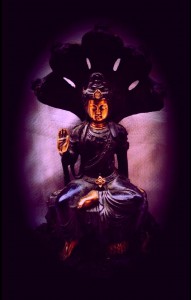Traditionally, we have entered into the Year of the Black Water Snake. Looked at from an astrological perspective, the snake falls under the Element of Water; although combined with the snake’s fiery energy can yield conflict. There have been numerous disasters occurring during this sign, like the attack of the World Trade Center in 2001 and the Stock Market Crash of 1929. Although contemplated from the mystical vantage point the full import shifts considerably. In the older annals of Indian Buddhism, the Naga was the symbol of Wisdom, much like the Dragon.The Nagas were the ancient protectors of the Dharma. In the Lankavatara Sutra, we find the Palace of the Sea Serpents (nagas) figuring as the opening scenario from which the Tathagata emerges and begins to expound the Buddhadharma. Earlier on, when Śākyamuni attained awakening at Bodhgayā, the Naga King became the first sentient being to receive the Buddhadharma. In this sense, the Naga is considered as a sign of the renewal of life, helping to perpetuate and protect the living teachings of the Tathagata. Śākyamuni was also sheltered from a violent wind and rainstorm—created during his struggle with Mara—by the protective coils of the Naga King. The following passages from the International Journal of Buddhist Thought and Culture (Hye-young Tcho: The Dragon in the Buddhist Korean Temples) further elaborates on the full import of the Nagas:
“From the tree of enlightenment, the Buddha moves to a succession of three trees, still meditating. The last tree belongs to the Naga King Mucilinda. A violent storm blows up. The Naga King glides down his tree and sheltered the Buddha from the rain, the cold and insects with his protective coils; he spreads his crown of hoods. While the Buddha stayed down the tree during seven days and seven nights with folded legs, the rain was pouring. As it ebbs, the Naga King Micilinda asked him also to stay in his palace and he too was given the Three Jewels and the Five Precepts, and became a pious follower (T.3.800a).
According to another tradition, when the Buddha used to teach the Perfection of Wisdom (Prajñaparamita) on the Vulture’s Peak, the books were entrusted upon the naga. This is perhaps the reason why important Buddhist scriptures were originally stored in the Naga King’s palace, and then were handed down to the famous monks invited by them. This procedure is used doubtless to justify the authenticity of the Buddha teachings and their sacred nature. The legend says that one of the most important Buddhist authors, Nagarjuna (2nd-3rd century), whose name includes the word naga and who was venerated in Asia as the founder of Madhyamika, the largest school of Mahayana Buddhism, noticed that two of his disciples vanished into the ground after his sermons. These two young men were actually nagas, who invited him to their palace and gave him seven volumes of the Prajñaparamitasutra. When he came back to earth, he revealed them to humankind and commented on its essence.* When Buddhism reached China in the 1st century and brought along its writings, the naga were replaced with the Dragons in the Chinese Translation. ”
*This tradition continues in Korea: it is in the palace of Dragon King where famous monks initiated themselves the secret Law and were receiving writings they passed on to men. The greatest Korean bonze of the 7th century, Wŏnhyo, was invited to the palace of the Dragon King, who presented him with his book. “According to the order given by the Sea Dragon, he received Buddha Dhyana Samadhisagara Sutra, of which he made the commentary” (Antiquities of the Three Kingdoms, Book IV, The interpretation of Meaning, Wŏnhyo, the Unbridled Monk). “The bonze Myŏngnang visited the palace of the Dragon King, where he learnt the Esoteric Law” (Antiquities of the Three Kingdoms, Book II, Wonder 2, King Munho Pŏpmin). Hye-young Tcho: The Dragon in the Buddhist Korean Temples.
As we can see, rather than being a harbinger of doom and gloom, the royal sign of the Naga (snake) bears a wonderful protective banner for the Buddhadharma. It can be reasoned that this Year of the Water Naga can truly be an auspicious one, provided one carefully and not recklessly handle the great treasures and mystical guidance hidden in the Sacred Bodhi-Cove they so diligently and faithfully protect. For Lankavatarians, the Lanka Buddha (Sacred Yidam, or protective guardian) is depicted as follows:


